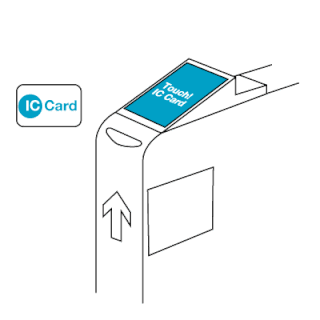Related Research Articles

A smart card (SC), chip card, or integrated circuit card is a physical electronic authentication device, used to control access to a resource. It is typically a plastic credit card-sized card with an embedded integrated circuit (IC) chip. Many smart cards include a pattern of metal contacts to electrically connect to the internal chip. Others are contactless, and some are both. Smart cards can provide personal identification, authentication, data storage, and application processing. Applications include identification, financial, public transit, computer security, schools, and healthcare. Smart cards may provide strong security authentication for single sign-on (SSO) within organizations. Numerous nations have deployed smart cards throughout their populations.
ISO/IEC 14443Identification cards -- Contactless integrated circuit cards -- Proximity cards is an international standard that defines proximity cards used for identification, and the transmission protocols for communicating with it.

A mobile payment, also referred to as mobile money, mobile money transfer and mobile wallet, is any of various payment processing services operated under financial regulations and performed from or via a mobile device, as the cardinal class of digital wallet. Instead of paying with cash, cheque, or credit cards, a consumer can use a payment app on a mobile device to pay for a wide range of services and digital or hard goods. Although the concept of using non-coin-based currency systems has a long history, it is only in the 21st century that the technology to support such systems has become widely available.

Near-field communication (NFC) is a set of communication protocols that enables communication between two electronic devices over a distance of 4 cm (1.57 in) or less. NFC offers a low-speed connection through a simple setup that can be used to bootstrap more capable wireless connections. Like other "proximity card" technologies, NFC is based on inductive coupling between two antennas present on NFC-enabled devices—for example a smartphone and a printer—communicating in one or both directions, using a frequency of 13.56 MHz in the globally available unlicensed radio frequency ISM band using the ISO/IEC 18000-3 air interface standard at data rates ranging from 106 to 848 kbit/s.

The EZ-Link card is a rechargeable contactless smart card and electronic money system that is primarily used as a payment method for public transport such as bus and rail lines in Singapore. A standard EZ-Link card is a credit-card-sized stored-value contact-less smart-card that comes in a variety of colours, as well as limited edition designs. It is sold by TransitLink Pte Ltd, a subsidiary of the Land Transport Authority (LTA), and can be used on travel modes across Singapore, including the Mass Rapid Transit (MRT), the Light Rail Transit (LRT), public buses which are operated by SBS Transit, SMRT Buses, Tower Transit Singapore and Go-Ahead Singapore, as well as the Sentosa Express.

MIFARE is a series of integrated circuit (IC) chips used in contactless smart cards and proximity cards.
OMA SpecWorks, previously the Open Mobile Alliance (OMA) is a standards organization which develops open, international technical standards for the mobile phone industry. It is a nonprofit Non-governmental organization (NGO), not a formal government-sponsored standards organization as is the International Telecommunication Union (ITU): a forum for industry stakeholders to agree on common specifications for products and services.
FeliCa is a contactless RFID smart card system from Sony in Japan, primarily used in electronic money cards. The name stands for Felicity Card. First utilized in the Octopus card system in Hong Kong, the technology is used in a variety of cards also in countries such as Singapore, Japan, Indonesia, Macau, the Philippines and the United States.
Java Card is a software technology that allows Java-based applications (applets) to be run securely on smart cards and more generally on similar secure small memory footprint devices which are called "secure elements" (SE). Today, a Secure Element is not limited to its smart cards and other removable cryptographic tokens form factors; embedded SEs soldered onto a device board and new security designs embedded into general purpose chips are also widely used. Java Card addresses this hardware fragmentation and specificities while retaining code portability brought forward by Java.
Java Card OpenPlatform (JCOP) is a smart card operating system for the Java Card platform developed by IBM Zürich Research Laboratory. On 31 January 2006 the development and support responsibilities transferred to the IBM Smart Card Technology team in Böblingen, Germany. Since July 2007 support and development activities for the JCOP operating system on NXP / Philips silicon are serviced by NXP Semiconductors.

Z-Wave is a wireless communications protocol used primarily for residential and commercial building automation. It is a mesh network using low-energy radio waves to communicate from device to device, allowing for wireless control of smart home devices, such as smart lights, security systems, thermostats, sensors, smart door locks, and garage door openers. The Z-Wave brand and technology are owned by Silicon Labs. Over 300 companies involved in this technology are gathered within the Z-Wave Alliance.
The OpenAjax Alliance is an industry group dedicated to the set of technologies and web programming techniques known as Ajax.
A contactless smart card is a contactless credential whose dimensions are credit card size. Its embedded integrated circuits can store data and communicate with a terminal via NFC. Commonplace uses include transit tickets, bank cards and passports.

Contactless payment systems are credit cards and debit cards, key fobs, smart cards, or other devices, including smartphones and other mobile devices, that use radio-frequency identification (RFID) or near-field communication for making secure payments. The embedded integrated circuit chip and antenna enable consumers to wave their card, fob, or handheld device over a reader at the Point-of-sale terminal. Contactless payments are made in close physical proximity, unlike other types of mobile payments which use broad-area cellular or WiFi networks and do not involve close physical proximity.
Calypso is an international electronic ticketing standard for microprocessor contactless smart cards, originally designed by a group of transit operators from 11 countries including Belgium, Canada, France, Germany, Italy, Latvia, México, Portugal and others. It ensures multi-sources of compatible products, and allows for interoperability between several transport operators in the same area.

UniPro is a high-speed interface technology for interconnecting integrated circuits in mobile and mobile-influenced electronics. The various versions of the UniPro protocol are created within the MIPI Alliance, an organization that defines specifications targeting mobile and mobile-influenced applications.
MIFARE4Mobile is a technical specification published by NXP Semiconductors in December 2008 to manage MIFARE-based applications in mobile devices. The specification provides mobile network operators and service providers with a single, interoperable programming interface, easing the use of the contactless MIFARE technology in future mobile Near Field Communication (NFC) devices.
Cubic Corporation is a global private transportation and defense corporation. It operates two business segments: Cubic Transportation Systems (CTS) and Cubic Mission and Performance Solutions (CMPS).

An automated fare collection (AFC) system is the collection of components that automate the ticketing system of a public transportation network – an automated version of manual fare collection. An AFC system is usually the basis for integrated ticketing.
Host card emulation (HCE) is the software architecture that provides exact virtual representation of various electronic identity cards using only software. Prior to the HCE architecture, near field communication (NFC) transactions were mainly carried out using hardware-based secure elements.
References
- ↑ Sayer, Peter (7 December 2010). "Card makers hope to shake security status quo". CSO Online. IDG News Service.
- ↑ "The open standard for public transport alliance makes its debut". EETimes Group. Archived from the original on 22 December 2013. Retrieved 16 July 2013.
- ↑ McLean, Heather (9 September 2011). "OSPT Alliance publishes open standard for contactless transit payments". NFC World . Retrieved 16 November 2011.
- ↑ "OSPT Alliance debuts at CARTES, announces open standard for fare collection". NFC News. 9 December 2010. Retrieved 16 November 2011.
- ↑ "An Open Standard for Next Generation Transit Fare Collection" (PDF). OSPT Alliance. Retrieved 16 November 2011.
- ↑ Clark, Sarah (16 December 2010). "Transport ticketing alliance debuts 'Cipurse' open alternative to Mifare". NFC World. NFC World. Retrieved 10 December 2011.
- ↑ "CIPURSE-Certified devices". OSPT Alliance. Retrieved 4 June 2014.
- ↑ "CIPURSE Product Certification". OSPT Alliance. Retrieved 4 June 2014.
- ↑ "About us". OSPT Alliance. Archived from the original on 3 November 2011. Retrieved 16 November 2011.
- ↑ "OSPT Alliance Members". OSPT Alliance. Retrieved 28 February 2019.